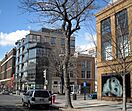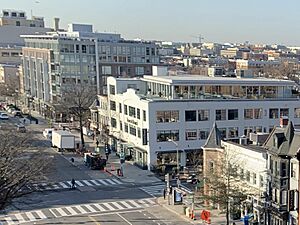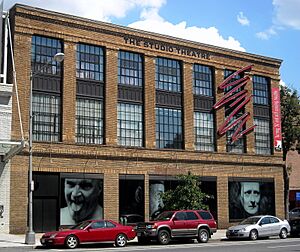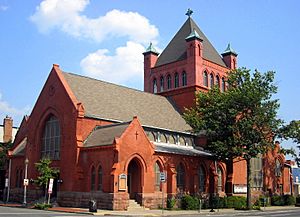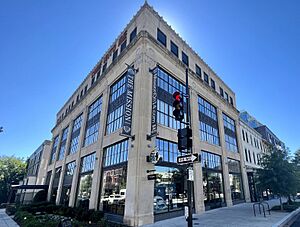Logan Circle (Washington, D.C.) facts for kids
Quick facts for kids
Logan Circle
|
|
|---|---|
|
Neighborhood of Washington, D.C.
|
|
|
Clockwise from the top: aerial view of Logan Circle; Le Diplomate; Luther Place Church; historic homes on Logan Circle; 14th Street.
|
|
 |
|
| Country | United States |
| District | Washington, D.C. |
| Quadrant | Northwest |
| Ward | 2 |
| Area | |
| • Total | .22 sq mi (0.6 km2) |
| combined area of census tracts 50.03, 50.04, 52.02, and 52.03 | |
| Population
(2020)
|
|
| • Total | 14,403 |
| • Density | 64,878/sq mi (25,050/km2) |
| combined populations of census tracts 50.03, 50.04, 52.02, and 52.03 | |
Logan Circle is a historic park and neighborhood in Washington, D.C.. It is located in the Northwest part of the city. Most of Logan Circle is residential, meaning people live there. However, 14th Street, which runs through the western part of the neighborhood, is full of shops and businesses.
In recent years, Logan Circle has been redeveloped. It has become one of Washington's most expensive neighborhoods. It is also known for being a welcoming place for many different people and communities. Logan Circle contains two historic districts. Many of its sites are listed on the National Register of Historic Places. The area began in the 1870s as a residential neighborhood. It was built for Washington's growing middle and upper classes. In 1901, President William McKinley unveiled the General Logan statue in the park's center. In 1930, the U.S. Congress officially named the circle after Union General John A. Logan.
Contents
Logan Circle's Past: A Look at Its History
How Logan Circle Began: The 1800s

During the American Civil War, the area that is now Logan Circle was home to Camp Barker. This was a camp for newly freed slaves from nearby Virginia and Maryland.
In the 1870s, Washington Mayor Alexander Robey Shepherd helped develop the area. He added streets, elm trees, and other features. Streetcar tracks were laid in this swampy area north of downtown Washington. This encouraged new buildings to be constructed.
Many Victorian row houses were built for the upper middle class. Washington wanted to be known as a city with wide boulevards and beautiful parks, like European capitals. Some larger homes had carriage houses and servant's quarters. These were later turned into apartments.
Changes in the 1900s

The park was first called Iowa Circle. In 1930, Congress renamed it for John A. Logan. He was a Civil War general and a U.S. representative and senator from Illinois. He lived at 4 Logan Circle.
At the center of the circle is the Major General John A. Logan statue. It shows General Logan on horseback. Franklin Simmons sculpted it. The bronze base was designed by architect Richard Morris Hunt. President William McKinley dedicated the 25-foot monument on April 9, 1901.
In the early 1900s, 14th Street NW became a major shopping area. It served both Black and White residents. It was also known for its auto showrooms. Further north, "14th and U" became a center for a large African-American community. This area, later called Shaw, included parts of Logan Circle.
Over time, the original Victorian homes were divided into apartments and rooming houses. After legal segregation ended, many middle-class residents moved away. Many also left after the 1968 Washington, D.C. riots. These riots badly damaged the 14th and U streets shopping areas.
In 1956, three lanes of 13th Street were paved through Logan Circle. This was done to help suburban workers get into D.C. faster. In 1980, these inner lanes were closed to encourage people to use the Metro train system. Later, the lanes were removed, and the park was restored.
During the 1980s and 1990s, Logan Circle became a hub for small, independent theater groups. They found affordable spaces north of the circle.
Logan Circle Today: The 2000s
In the 2000s, the area saw gentrification. This means that older buildings were torn down or fixed up, and housing costs went up. The shopping areas along 14th and P streets were greatly improved.
These streets now have many different shops, restaurants, art galleries, live theater, and nightlife spots. A big event for the neighborhood was the opening of a Whole Foods Market in December 2000. Before this, there was no large grocery store in the area. This store is now one of the chain's busiest.
The changes in Logan Circle have led to a shift in who lives there. Since the 1990s, many Black families have moved out because of rising prices.
Important Places: Logan Circle Landmarks
|
Logan Circle Historic District
|
|

Row houses on the northeast corner of Logan Circle, including the former home of writer Ambrose Bierce
|
|
| Location | Junction of 13th Street, P Street, Rhode Island Avenue, and Vermont Avenue, NW |
|---|---|
| Area | 18 acres (7.3 ha) |
| Architectural style | Second Empire, Italianate, Richardsonian Romanesque, Queen Anne |
| NRHP reference No. | 72001426 |
| Added to NRHP | June 30, 1972 |
Logan Circle Historic District
The Logan Circle Historic District covers an eight-block area around the circle. It has 135 homes from the late 1800s. Most of these homes are built in the Late Victorian and Richardsonian Romanesque styles. This district was added to the National Register of Historic Places on June 30, 1972.
The former home of Mary McLeod Bethune is located here. She was an important African American educator and civil rights leader. She founded the National Council of Negro Women. Her home at 1318 Vermont Avenue NW is now a National Historic Site. It houses the Mary McLeod Bethune Memorial Museum.
Fourteenth Street Historic District
Besides the Logan Circle Historic District, the neighborhood also includes the larger Fourteenth Street Historic District. This district was added to the NRHP in 1994. It has about 765 important historical buildings. These buildings show how the area grew because of one of Washington, D.C.'s first streetcar lines, built in the 1880s.
The oldest church in the Fourteenth Street Historic District is Luther Place Memorial Church. It was built between 1870 and 1873. It is on the north side of Thomas Circle. The church was renamed in 1884 after a bronze statue of Martin Luther was placed on its property. Luther Place Memorial Church was added to the National Register of Historic Places on July 16, 1973.
The Gladstone and Hawarden buildings were designed by architect George S. Cooper in 1900. They are early examples of apartment houses for Washington's middle class. These are the first known twin apartment buildings in Washington, D.C. They were added to the NRHP on September 7, 1994.
Other Notable Places
The District of Columbia Inventory of Historic Sites lists several other important properties in Logan Circle. These include the former homes of:
- Charles Manuel "Sweet Daddy" Grace, who founded the United House of Prayer For All People.
- John A. Lankford, the first African American architect in Washington, D.C.
- Belford Lawson Jr., a lawyer in the important case New Negro Alliance v. Sanitary Grocery Co..
- Alain LeRoy Locke, the first African American Rhodes Scholar and a key figure in the Harlem Renaissance.
- Mary Jane Patterson, the first African American woman to earn a bachelor's degree.
- Ella Watson, who was the subject of Gordon Parks's famous photograph American Gothic, Washington, D.C..
- James Lesesne Wells, a noted graphic artist and art teacher at Howard University.
The Victorian building at 15 Logan Circle was built for military officer Seth Ledyard Phelps. It served as the Korean legation (like an embassy) from 1889 to 1905. After a big restoration, it is now the Old Korean Legation Museum.
The Iowa building, designed by Thomas Franklin Schneider in 1901, was the birthplace of anthropologist Julian Steward.
Logan Circle's Location and Features
The Logan Circle neighborhood has these borders:
- To the north: T Street NW and the U Street Corridor.
- To the east: 12th Street NW and the Shaw neighborhood.
- To the south: Massachusetts Avenue or M Street NW and Downtown D.C..
- To the west: 16th Street NW and the Dupont Circle neighborhood.
The traffic circle itself is where 13th Street, P Street, Rhode Island Avenue, and Vermont Avenue meet. The National Park Service takes care of the park inside the circle. This park is 360 feet across. It has wooden benches, decorative lampposts, an iron fence, and concrete sidewalks.
Who Lives in Logan Circle?
| Census | 2020 | 2010 | 2000 | 1990 | 1980 | 1970 | 1960 |
|---|---|---|---|---|---|---|---|
| Population | 12,391 | 12,098 | 11,837 | 10,932 | 9,413 | 12,656 | 14,267 |
The types of people living in Logan Circle are changing. This is due to the area becoming more expensive. For example, the number of Black residents decreased from about one-quarter to about one-tenth between 2010 and 2020. At the same time, the number of White residents increased from about 59% to about 70%. The Asian population also grew by about 9%.
| Race/Ethnicity | Change 2020 vs. 2010 |
2020 | 2010 |
|---|---|---|---|
| Non-Hispanic (NH) White | +10.7% | 70.1% | 59.4% |
| Hispanic or Latino | –2.9% | 16.0% | 18.9% |
| NH Black | –14.4% | 9.8% | 24.2% |
| NH Asian (2020) NH Asian or Pacific Islander (2010) |
+0.3%* | 5.0% | 4.7% |
| NH Multiracial | +2.0% | 4.5% | 2.5% |
| NH Some other race | –0.1$ | 0.4% | 0.5% |
| NH American Indian and Alaska Native | +0.2% | 0.25% | 0.05% |
| NH Native Hawaiian and Pacific Islander | n/a | 0.2% | n/a |
- +0.3% plus 0.2% (Asian increase plus Pacific Islander category which was split out in 2020
Education in Logan Circle
Students in Logan Circle attend schools run by the District of Columbia Public Schools (DCPS). Garrison Elementary School in Logan Circle can hold over 350 students. As of 2013, the school had 228 students. Residents are assigned to Garrison and to Cardozo Education Campus.
Images for kids



